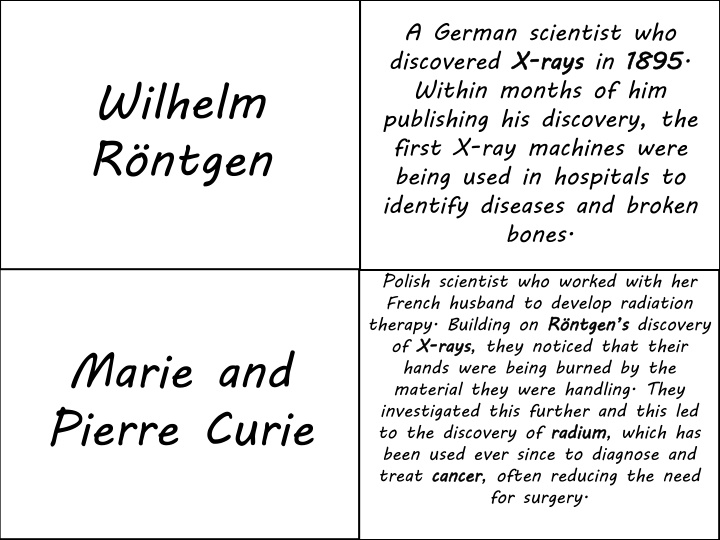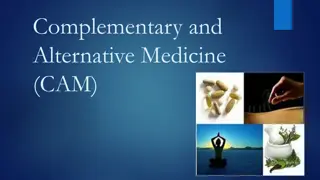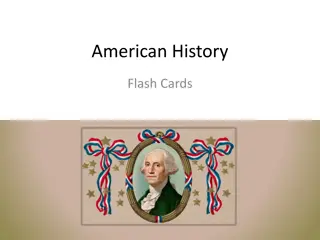
Pioneers in Medicine: X-Ray Discovery, Blood Groups, and Modern Surgery
Explore the groundbreaking contributions of key figures in the history of medicine, from the discovery of X-rays by Wilhelm Röntgen to the advancement of blood transfusions and surgical techniques by Karl Landsteiner, Archibald McIndoe, and Christiaan Barnard. Learn about the influential teachings of Hippocrates, Dioscorides, and more on natural treatments and medical philosophies.
Download Presentation

Please find below an Image/Link to download the presentation.
The content on the website is provided AS IS for your information and personal use only. It may not be sold, licensed, or shared on other websites without obtaining consent from the author. If you encounter any issues during the download, it is possible that the publisher has removed the file from their server.
You are allowed to download the files provided on this website for personal or commercial use, subject to the condition that they are used lawfully. All files are the property of their respective owners.
The content on the website is provided AS IS for your information and personal use only. It may not be sold, licensed, or shared on other websites without obtaining consent from the author.
E N D
Presentation Transcript
A German scientist who discovered X X- -rays Within months of him publishing his discovery, the first X-ray machines were being used in hospitals to identify diseases and broken bones. rays in 1895 1895. Wilhelm R ntgen Polish scientist who worked with her French husband to develop radiation therapy. Building on R ntgen s of X X- -rays hands were being burned by the material they were handling. They investigated this further and this led to the discovery of radium been used ever since to diagnose and treat cancer for surgery. R ntgen s discovery rays, they noticed that their Marie and Pierre Curie radium, which has cancer, often reducing the need
Discovered the existence of blood groups in 1901. After this, successful blood transfusions became possible, but only if the donor and the patient were in the same place, because the blood would quickly clot and become useless. This problem was solved during WW1. There was a huge need for blood, so scientists researched ways that blood could be stored without clotting. Sodium citrate was added to blood, which solved the problem. Used skin grafts to reconstruct faces and hands destroyed by fire. He carried out 4000 operations on soldiers who had been burned during WW2. Karl Landsteiner Archibald McIndoe
Greek God of healing. His daughters were Panacea and Hygieia. The Greeks believed that he had a snake that could cure blindness by licking patients eyelids. He is usually shown with his snake twined around his staff (this is now an internationally recognised symbol for medical care/hospitals) Asclepius One of the great Greek philosophers. His interest in biology led him to dissect animals and plants. This method was copied by others for centuries. He suggested that the heart and the brain are the most important organs, and they work together to control the body. William Harvey (who discovered the circulation of blood in the 1600s) admired his approach. Aristotle
South African heart surgeon famous for carrying out the world s first heart transplant in 1967. The patient died after 18 days, but much was learned from the process, and since then many successful heart transplants have been performed. Christiaan Barnard Father of modern medicine. Lived in Ancient Greece. He is remembered for: The Hippocratic Oath that all doctors take to this day The Hippocratic Collection of books His emphasis on observing and recording symptoms. He was the first to say that this would help doctors diagnose patients. He encouraged doctors to look for natural treatments for illnesses rather than praying to the Gods The Four Humours (blood, phlegm, yellow bile, black bile). He believed that if the humours become unbalanced then a person becomes ill. Hippocrates
A Greek surgeon in the Roman army. He wrote a book describing many herbal remedies. These remedies contained ingredients such as honey and garlic, that would have helped patients by killing infections. Dioscorides Greek physician and surgeon who lived in the Roman empire. He built on the work of Hippocrates in several ways. He believed that illness was caused by imbalances of the four humours, and thought careful observation was vital. He prescribed a healthy diet and exercise to cure illness He developed a Theory of opposites to help balance the humours. (EG: Runny nose too much phlegm eat hot peppers) Focused more on anatomy than Hippocrates, thought dissection was an important learning tool, usually of apes Publicly dissected a pig to demonstrate his discoveries about the nervous system Wrote hundreds of books, that were used by medical students for 1500 years His ideas fit in with the Bible, so for centuries Christians did not question his teachings. Galen
An Arab doctor. Known in Europe as Avicenna. Wrote a medical encyclopedia called The Canon . This was used to teach European physicians until the 1600s. He included the work of the Greeks and his own methods. He was known as the Galen of Islam . An Arab doctor. Known in Europe as Rhazes. He wrote over 200 books, including his own ideas, but also believed it was important to learn from the work of ancient physicians. Ibn Sina al-Razi
Arab doctor. Investigated the anatomy of the heart, and was brave enough to challenge Galen. Galen said that blood moves from one side of the heart to the other side through invisible channels al-Nafis observed that these channels did not exist. He said that blood moves from the heart to the lungs and back again, therefore circulating around the body. (Nobody built on his work, and it wasn t until the 1600s that this discovery was made in Europe) Ibn al-Nafis Military surgeon from the early Medieval period. He taught his students to bathe and cleanse wounds, and close them up quickly without trying to form pus. (Doctors used to believe that pus was a sign that a wound was healing) Henri de Mondeville
Royal surgeon from medieval times. Designed a forcep to help remove arrowheads on the battlefield. The wound would then be spread with honey to stop infection. John Bradmore Two surgeons (father and son) from Medieval Italy. They were the very first to claim that pus does not help a wound to heal. They encouraged the use of wine to help heal wounds. Hugh and Theodoric
Medieval surgeon. Wrote the first European textbook on surgery in 1180. Roger of Salerno Medieval surgeon. Claimed that surgeons should receive as much education as doctors. (Early medieval surgeons = barber surgeons, little education). Wrote a seven-volume book , Chirurgia Magna ( Great Surgery ) and filled it with the work of great doctors. Guy de Chauliac
Renaissance polymath (polymath = somebody who is very good at a large number of things). He encouraged young artists to understand human anatomy (sinews, muscles, nerves ). He thought if they understood the human body they could better represent it in art. Leonardo da Vinci The inventor of the printing press (c.1450) By 1500, printing presses were used around Europe, and this helped to spread medical knowledge and ideas. Johannes Gutenberg
Renaissance doctor and surgeon. Wrote The Fabric of the Human Body (1545), a detailed and fully illustrated description of human anatomy. He respected Galen s work, but proved that Galen was wrong in three ways: The human jaw bone is made from one bone (Galen said it was two) The breastbone has three parts (Galen said seven) Blood does not flow into the heart through invisible holes in the septum such holes do not exist. NOTE: didn t actually make anyone healthier, his work was only a start. He also showed that doctors could learn more about anatomy, and had to carry out human (not animal) dissection to learn more. Andreas Vesalius NOTE: Many doctors disputed this and he was criticised. Also, Vesalius Renaissance doctor. King Charles I s personal physician. Wrote An Anatomical Account of the Motion of the Heart and Blood (1628). This book described how blood circulates around the body, and that the body has a one way system for blood. Harvey proved that the heart acts as a pump. He proved this with dissection of humans and animals. NOTE: was only gradually accepted, as it contradicted Galen. Many patients stopped seeing him as they thought he was mad. Also, his ideas did not make anyone better, it was only a start. William Harvey NOTE: His discovery
Renaissance surgeon. Spent 20 years as an army surgeon, and then was surgeon to kings of France. Most famous surgeon in Europe because of his books Ten Books on Surgery and Apology and Treatise . He changed the treatment of gunshot wounds, as he replaced the use of boiling oil on wounds with his own mixture of egg yolks, rose oil and turpentine. He used ligatures to stop bleeding (silk threads tied around individual blood vessels) rather than using a cauterising iron, which he thought was cruel. He also designed and made the first false limbs for wounded soldiers, and included drawings of them in his books to spread the idea. NOTE: cauterisation was more practical on the battlefield. Ligatures could also encourage deadly infection. Also, his discoveries were small scale: there was still no antiseptics/knowledge of blood groups. Town doctor during the Renaissance. Vesalius, Par and Harvey corrected elements of Galen s work, but this doctor said that Galen and Hippocrates were wrong about almost everything. He said that illnesses were caused by chemicals in the body, and that treatments should be treated with chemicals. This sounds more scientific, but he also believed that God sent secret messages/clues about how to treat diseases. (EG: Orchids are shaped like testicles, so can treat STIs.) People didn t listen to him, because they didn t want Galen s ideas to be challenged. Ambroise Par NOTE: Stopping bleeding with ligatures was slow Paracelsus
Renaissance doctor. Said that blood moved along the veins and arteries. William Harvey built on his work. Realdo Columbo Renaissance doctor. William Harvey s tutor at Padua University. Proved that there are valves in veins. Fabricus
Author of The Complete Herbal which was published during the Renaissance (thanks to Gutenberg s printing press). It recommended simple homegrown herbal remedies. Nicholas Culpeper Watched inoculation carried out in Turkey, and then had her daughter inoculated in England in front of doctors. This helped to spread the idea of inoculation as a way of avoiding disease. Lady Mary Wortley Montagu
18thcentury doctor. Wrote An Enquiry into the Causes and Effects of Variola Vaccinae, known by the name of Cowpox . (1798) This showed that vaccination could save people from catching smallpox. He called his method vaccination because the Latin word for cow is vacca . By 1803, vaccination was being used in the USA, and Napoleon has the whole French army vaccinated in 1805. In 1852, vaccination was made compulsory in Britain. By 1980, smallpox was globally wiped out. Remember that he didn t know that germs caused disease. NOTE illness was a punishment for sin, a lot of doctors said it was too revolutionary, and it was against Gods law to give people an animal disease. They also didn t want to trust the word of a country doctor , and thought the government should not be interfering in people s lives. Edward Jenner Remember that he didn t know that germs caused disease. NOTE: Many people opposed vaccines because they thought Published his Germ Theory in 1861. Carried out a series of experiments to prove that bacteria (germs) make milk and beer go bad, and that bacteria causes diseases in animals. In 1864 he convinced other scientists that his theory was correct. He also developed vaccines for animal diseases, and for treating rabies in humans. Pasteur was mocked by scientists who believed in theory of spontaneous generation. Louis Pasteur
Developed the scientific methods during the 1870s that helped scientists to identify specific bacteria. He discovered the bacterium that causes tuberculosis (TB). Other scientists used his methods to discover the bacteria that causes other diseases. Robert Koch Part of Koch s research team. Developed the first magic bullet called Salversan 606. It was called a magic bullet because it homed in on and desyroyed the bacteria that caused syphilis. Paul Erlich
Developed the drug Prontosil in the 1930s. This was the second magic bullet , which cured blood poisoning. This helped other scientists develop a cure for illnesses like pneumonia. Gerhard Domagk Discovered penicillin by chance in 1928, and thereby revolutionised the way that doctors treated disease and infection in patients. Discovered that the mould in his petri dish had created a bacteria-free circle around itself. He named the active substance in the mould penicillin . The development of penicillin marked the start of modern antibiotics, and saved an estimated 200 million lives in less than 70 years. Alexander Fleming
Developed the discovery made by Alexander Fleming (penicillin) into an actual medical treatment, using funding from the US government. Howard Florey and Ernst Chain They discovered the structure of human DNA in 1953, and how it is passed on from parents to children. Their work enabled the Human Genome Project (1990s) to explain how each part of human DNA affects the human body. Francis Crick and James Watson
Made some of the earliest microscopes, and he realised that everything contained tiny organisms (he called them animacules ). He wrote papers for the Royal Society in London. Lister used his ideas to further develop the microscope. A civil servant who worked for the Poor Law Commission in the 1830s and 1840s. He published his Report on the Sanitary Conditions of the Labouring Population in 1842. The report showed that poverty was a vicious circle: The poor live in dirty/crowded conditions, which makes them ill Many people are too ill to work, and that makes them poorer Therefore, other people have to pay higher taxes to help the poor, which makes THEM poorer. He said that to sort this out the government should: Improve drainage and sewers Get rid of rubbish from the streets Provide clean water Appoint medical officers in each area to make sure these reforms are being carried out. NOTE: There was lots of opposition to Chadwick s report because people didn t want to pay extra tax to make these reforms happen (even though it meant lower taxes in the long run). They also didn t want the government interfering in local matters. Anthony van Leeuwenhoek Edwin Chadwick
Nineteenth century civil servant. He used population data to show where the death rate was highest, and what people died of. This proved the link between a high death rate and unhealthy living conditions, and put pressure on the government to make changes. William Farr Public heath and surgery pioneer. Wrote a book in 1849 sharing his opinion that cholera spread through dirty water, not bad air , but other doctors mocked him. In 1854, he proved his theory by pointing out that the majority of the people who died of cholera in the Broad Street area all used the same water pump. His report was called On the Mode of Communication of Cholera . NOTE: was essential for preventing the spread of cholera, the government still did not take action. Many scientists also still clung to the bad air theory (this was before Pasteur published his germ theory in 1861. John Snow NOTE: Even though Snow proved that clean water
A campaigner who worked hard to improve housing for working class people. She was appalled by the homes of the children that she taught, and bought three slum houses in 1865 and cleaned them up to show how to provide healthy homes for people. Over time, she took over 2000 houses. This idea led to similar schemes elsewhere. Her influence helped to persuade the government to pass the 1875 Artisan s Dwelling Act, which gave the councils the power to knock down slums if they were too dangerous or unhealthy. Octavia Hill The engineer who designed and built London s sewer system after the Great Stink of 1858. The system that he built is still used today. It included: 83 miles of main sewers, built underground from brick 1100 miles of sewers for each street, which connected to the main sewers A series of pumping stations to drive the flow of sewage along the pipes He had the foresight to take population growth into account, by making sure that the sewers could deal with lots more sewage than it needed to at the time. The building work took 17 years to complete. Joseph Bazalgette
A reformer who investigated poverty and living conditions in York. Published Poverty: a Study of Town Life in 1901. This report showed that the people of York were living in poverty even though they were in work, and this was having a serious impact on their health. This led him to increase his own workers wages. In 1941 he published a new report Progress and Poverty which showed a 50% reduction in poverty since 1901. Liverpool businessman and friend of Octavia Hill. Collected evidence about poverty in the East End of London in 1886. Discovered that 35% of people were living in poverty. He was appalled by these results, and argued that the government had to take responsibility for caring for people in poverty. One of his suggestions was an old-age pension. Seebohm Rowntree Charles Booth
Prime minister of Britain (1916 1922). Became a Liberal MP in 1980, and was the Chancellor of the Exchequer in the Liberal government that introduced all the social welfare reforms between 1902 1912. He insisted on raising taxes on the well-off to pay for old-age pensions. He also introduces the National Insurance Act of 1911. David Lloyd George Leading civil servant. Wrote a report on what should be done to improve people s lives. He played a key part in organising the 1911 National Insurance scheme. His report recommended: Setting up a National Health Service, free for everyone and paid for by taxes. Doctors/nurses would become government employees, instead of charging the sick. Everyone in work should pay National Insurance out of their wages. They would pay benefits (sick pay, old-age pensions, unemployment pay) to everyone whether they were working or not. His report was greeted with enthusiasm 600,000 copies were sold. Sir William Beveridge
Professor of Midwifery at Edinburgh University. Experimented with chloroform in 1847, and established that it is an effective anaesthetic without some of the drawbacks of ether. James Simpson Discovered in 1799 that laughing gas (nitrous oxide) reduced the sensation of pain. He suggested that it could be used in surgery and by dentists. Sir Humphrey Davy
Son of a Welsh coal miner. Worked for the miners union, which gave him experience of poverty and sickness. Became MP for Ebbw Vale in 1929. He was an inspiring speaker, and an idealist who was determined to make life better for working people. His speeches won support for the NHS. Famous London surgeon from the 1800s who was well known for carrying out operations quickly. This was a desirable skill because there were no reliable anaesthetics, so the quicker an operation was carried out, the better. He once amputated a leg in 2 and a half minutes, but accidentally cut off the patient s testicles as well. Aneurin Bevan Robert Liston
An American dentist who became convinced of the value of laughing gas (nitrous oxide) as an anaesthetic after inhaling it at a fair. However, when he used it in a public demonstration his patient was in agony. This killed off an confidence in laughing gas as an anaesthetic. Horace Wells A doctor who worked at the General Hospital in Vienna. In 1847 he instructed the medical students and doctors to wash their hands after dissecting dead bodies. He observed that mothers and babies helped by midwives were less likely to die than those helped by doctors. He called doctors who did not wash their hands murderers . Unfortunately, other doctors thought he was mentally unstable and ignored his ideas. NOTE: his Germ Theory until 1861. Ignaz Semmelweiss NOTE: Remember, Pasteur did not publish
Famous 19th century surgeon. Came up with the idea of using carbolic acid to prevent infection. He knew all about Pasteur s germ theory, and discovered in his experiments on patients with compound fractures that if carbolic acid was applied to the wound, then patients would not develop gangrene, and would therefore not have to have their limb amputated. Joseph Lister 19th century surgeon who came up with the idea of surgeons wearing rubber gloves during operations. William Halstead
A wealthy 19th century woman who trained to be a nurse. She took 38 nurses to the Crimea when the Crimean War broke out in 1854. She was appalled by the conditions of the hospital in Scutari, and cleaned up the hospital and the patients, making sure the environment and the medical equipment was spotless. The death rate at the hospital fell from 40% to 2%. She wrote two books which were influential all over the world: Notes on Nursing (1859) and Notes on Hospitals (1863). NOTE: Theory (1861), but associated disease with dirt. She thought that a nurse should focus on the practical, and not on theory/science. Florence Nightingale NOTE: She paid little attention to Pasteur s Germ Born in Bristol, she had to go to the USA to train to be a doctor. She qualified in 1849, and set up the New York Infirmary for Poor Women and Children which was staffed completely by women. She also travelled back to Britain to encourage other women to become doctors, including Elizabeth Garrett Anderson. Elizabeth Blackwell
Elizabeth Garrett Anderson The first woman to qualify as a doctor in Britain. This inspired other women to do the same, despite several attempts from men to stop them. In 1876, a law was passed opening all medical qualifications to women. Daughter of a local healer in Jamaica, and a knowledgeable healer and midwife. She showed people in Panama how to deal with an outbreak of cholera, how to deal with gunshot wounds, and why some patients should be isolated. In 1854, she heard about the Crimean War, and travelled to Britain to volunteer her services to the army, but they declined. She then paid her own way to the Crimea. In the Crimea she set up the British Hotel which provided food and drinks for soldiers. She also treated sickness and tended the wounded on the battlefield. Her bravery made her very popular with the soldiers. After the war, nobody in Britain paid much attention to her or learned from her medical skills. Mary Seacole






















